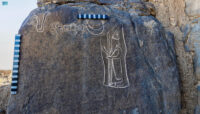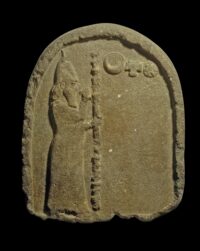 A 6th century cuneiform inscription dedicated by King of Babylon Nabonidus has been discovered in northern Saudi Arabia. At 26 lines long, it is the longest cuneiform inscription ever found in the country.
A 6th century cuneiform inscription dedicated by King of Babylon Nabonidus has been discovered in northern Saudi Arabia. At 26 lines long, it is the longest cuneiform inscription ever found in the country.
The inscription was carved on a basalt rock face in Al Hait, the ancient city of Fadak, in the Hail region. A large petroglyph of the king holding a staff is on the right side of the stone. Above him to the left are four religious symbols: a serpent, the sun, a rosette and the crescent moon. They represent deities of the Mesopotamian pantheon — the star of Ishtar, the winged disc of the sun god Shamash, the crescent of the moon god Sin –that the king is praying to with his raised hand. The crescent is nearest to him and is the largest, illustrating the importance of the moon god Sin to Nabonidus who sought to elevate Sin over Babylon’s traditional patron deity Marduk.
His devotion to Sin may explain, at least in part, in his presence on a rock face in Saudi Arabia. Four years after he ascended to the throne of the Neo-Babylonian Empire, perhaps the result of a coup as his inscriptions explicitly deny any royal heritage, Nabonidus went into exile in Tayma, about 160 miles north of Al Hait. The reason for his self-imposed removal from the center of political and religious power is unknown, but it’s likely clashes with the clergy and elite over his attempts to transform the hierarchy of Babylon’s gods and make the moon supreme over all the others played a pivotal role.
 He still ruled the empire from a distance — his son Belshazzar acted as his representative on the ground in Babylon — and he would return a decade later undeterred in his zeal for religious reform. He built a temple to Sin in Harran (modern-day Turkey) and a stela discovered there in the 1950s bears almost identical iconography to the Al Hait petroglyphs, albeit with far more refined carving.
He still ruled the empire from a distance — his son Belshazzar acted as his representative on the ground in Babylon — and he would return a decade later undeterred in his zeal for religious reform. He built a temple to Sin in Harran (modern-day Turkey) and a stela discovered there in the 1950s bears almost identical iconography to the Al Hait petroglyphs, albeit with far more refined carving.
The long cuneiform inscription underneath the symbols has not been fully deciphered yet. Archaeologists hope the inscription may shed new light on Nabonidus’s time in what is now Saudi Arabia.
Details of the discovery will be released after specialists have more time to analyze. It will be linked to previous results that have been documented in the northwest of the Kingdom.
This archaeological finding will accompany previous discoveries of stone inscriptions and obelisks in a number of sites between Tayma and Hail that mention King Nabonidus, who ruled from 556 to 539 B.C. The finding proves the expansion of cultural and commercial contact between the Arabian Peninsula and the Mesopotamian civilizations.
Shouldn’t it be 6th century BC?
Please keep us informed on this as the inscription is translated.